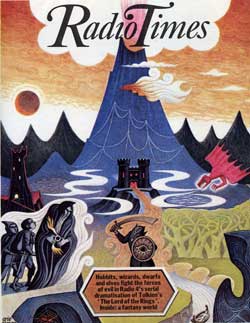For any of you interested in illustration there was a brilliant programme on Radio 4 today, presented by Peter Day, discussing the artwork used in the Radio Times over its 90 year life span. It’s called The Art of the Radio Times and you can catch it again here. In its earlier decades the Radio Times played an important part in nurturing illustration talent and featured work by illustration greats from Val Biro through to Peter Brookes. It was brilliant to hear Peter Brookes talking of the panic the commission caused, which would arrive on the Thursday and have to be back in by the following Tuesday. To see Peter Brookes’ political satire in The Times it’s hard to imagine him ever panicking!
Towards the end of the programme Peter Day asked the current Radio Times editor whether the magazine had the same role in commissioning illustration. In response he cited a cover by Peter Blake and another by David Hockney in recent years. There was no insight at all from him that, whereas the early generations of Radio Times art directors had taken talent fresh from art college he’d commissioned two well-established artists. How sad.
Anyway, do follow the link to the programme where there is a gallery of images from the Radio Times over the years. Two of my favourites are one by Stanley Herbert from 1934 called Whitsun Number showing a man walking through the countryside, and another by John Gilroy from 1936 showing a big cat chuckling away.
A quick note on birds: I have given up on the Song Thrush entirely. I think I’ll have to come back to it in the spring when they’re around. I just couldn’t get it at all. So, now we’re on to the Chaffinch. Simon Barnes in Birdwatching With Your Eyes Closed says that the Chaffinch got its name from one of the calls (“finch”) it would make when searching through chaff for seed on the threshing floor. Here is the link to their song. They are the second most common breeding bird in the UK so I should be able to get this one.
Also, I must tell you that I’ve finally got round to picking up Roger Deakin’s book Wildwood. I mentioned wanting to read it here. It is absolutely brilliant. I can’t recommend it highly enough. It’s just beautiful.








Hello Hannah
I found your blog courtesy of Stanley Herbert. I was looking to see if there were any of his scraperboard illustrations for sale. (Can’t find any).
This was because we went to barter books in Alnwick on Sunday and I found a little book illustrated by him. I think they might have been done on white sb then scraped. Very fine indeed.
I am also an illustrator, ex D of J Dundee 1971-76, and have a renewed interest in scraperboard. I have been wood-engraving for years but sb is much quicker for illustration purposes. Have you used it at all?
Do you know ‘BB’? or Denys Watkins Pitchford to give him his full name. All his books were illustrated with his own scraperboard drawings. I still have ‘Wild Lone’ bought on KingsCross station c. 1958.
I loved it.
I have just been given Deakin’s book Notes from Walnut Tree farm which is the form of a diary, and Robert MacFarlanes’ Landmarks.
Both lovely writers. The latter has illustrations by Jonathan Gibbs, whom I know and you may well do.
Must shut up now. Enjoying your blog.
Best wishes
Ken Wilson
Hello Ken. Stanley Herbert is wonderful and so is Barter Books – I’m very envious you were there so recently! I’ve never used scraperboard but I have several illustrator friends who use it regularly when they need to get a printmaking-based commission done quickly and rave about its versatility. Thanks for the recommend of BB. I didn’t think I knew him and then looked up his work and of course he wrote The Little Grey Men. I loved that book as a child. Yes, I know Jonathan Gibbs very well – he was one of my lecturers at Edinburgh. He’s just brilliant. Speaking of brilliant, your website is a bit of a treasure trove! Thanks for getting in touch and glad you like the blog 🙂